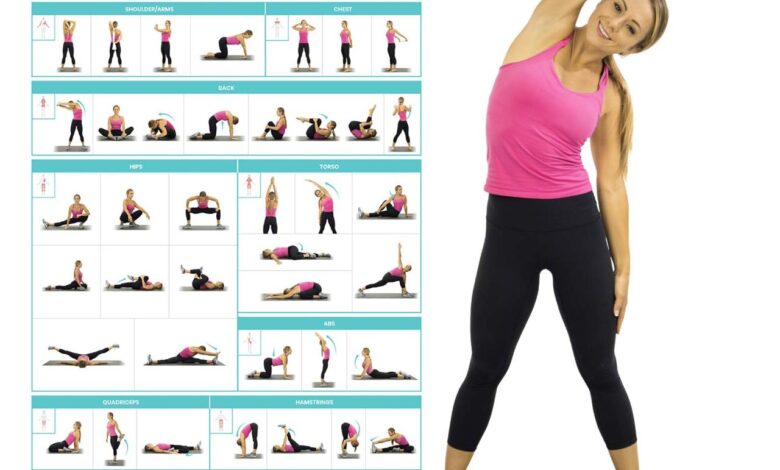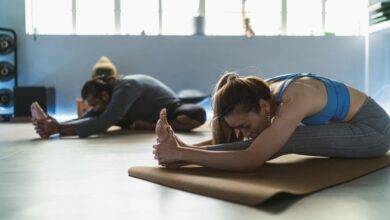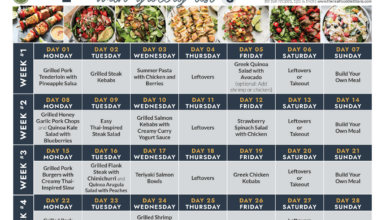
Your Go-To Guide for Stretching: Flexibility, Strength, and Wellness
Your go to guide for stretching – Your go-to guide for stretching is more than just a series of exercises; it’s a roadmap to a healthier, more resilient you. Stretching isn’t just about improving your flexibility; it’s about unlocking your body’s potential for strength, mobility, and overall well-being.
This guide delves into the science behind stretching, exploring its benefits, different techniques, and how to incorporate it into your daily life. We’ll cover everything from static stretches to dynamic stretches, common mistakes to avoid, and resources to help you achieve your stretching goals.
Your Go-To Guide for Stretching
Stretching is an essential part of a healthy lifestyle, often overlooked but offering numerous benefits for your physical and mental well-being. Whether you’re an athlete, a desk worker, or simply looking to improve your overall health, incorporating regular stretching into your routine can make a significant difference.
Benefits of Stretching
Stretching regularly offers a range of benefits that can improve your quality of life.
- Increased Flexibility and Range of Motion: Stretching helps lengthen muscles and improve joint mobility, allowing for greater flexibility and range of motion. This can be especially beneficial for athletes, dancers, and anyone who performs repetitive movements.
- Reduced Risk of Injuries: Stretching can help prevent injuries by improving muscle elasticity and reducing muscle tightness. When muscles are flexible and able to move through a full range of motion, they are less likely to tear or strain.
- Enhanced Performance: Stretching can improve athletic performance by increasing muscle efficiency and reducing the risk of injury. Warming up with dynamic stretches before exercise can help prepare your body for activity, while static stretches after exercise can aid in recovery.
- Stress Relief: Stretching can be a great way to relieve stress and tension. Holding a stretch can help release endorphins, which have mood-boosting effects.
- Improved Posture: Stretching can help improve posture by strengthening core muscles and lengthening tight muscles in the back and shoulders. This can reduce back pain and improve overall body alignment.
Types of Stretching
There are three main types of stretching:
- Static Stretching: This involves holding a stretch for a sustained period, typically 15-30 seconds. Static stretches are best performed after exercise, when muscles are warm.
- Dynamic Stretching: This involves moving through a range of motion, such as arm circles or leg swings. Dynamic stretches are best performed before exercise, as they help warm up muscles and prepare them for activity.
- Ballistic Stretching: This involves bouncing or swinging movements to stretch muscles. While ballistic stretching can be effective, it can also increase the risk of injury if not performed correctly. It is generally not recommended for beginners.
Understanding Your Body’s Needs

Stretching is a crucial part of any fitness routine, but it’s important to approach it with an understanding of your individual needs and limitations. Just like any other exercise, stretching should be tailored to your body, taking into account your current fitness level, any injuries or conditions you might have, and your personal goals.
Assessing Individual Needs and Limitations
Before diving into a stretching routine, it’s essential to assess your body’s capabilities and limitations. This involves understanding your current flexibility, identifying any areas that might require extra attention, and recognizing signs of pain or discomfort. A simple self-assessment can be a good starting point.
- Observe your range of motion:Try basic movements like reaching for your toes, rotating your shoulders, and bending your knees. Pay attention to any limitations or stiffness you experience.
- Identify areas that need stretching:Do you feel tightness in your hamstrings, lower back, or neck? These areas often benefit from targeted stretching.
- Recognize signs of pain or discomfort:Stretching should never be painful. If you experience sharp pain or discomfort, stop immediately and consult with a healthcare professional.
Proper Warm-Up and Cool-Down Routines
Warming up before stretching is crucial for preparing your muscles and preventing injury. A light cardio session, such as brisk walking or jogging, followed by dynamic stretches can effectively increase blood flow and prepare your body for stretching. Similarly, cooling down after stretching helps your body recover and prevent muscle soreness.
- Warm-up:A warm-up routine typically includes light cardio and dynamic stretches. Dynamic stretches involve controlled movements that gradually increase your range of motion. Examples include arm circles, leg swings, and torso twists.
- Cool-down:After your stretching session, engage in gentle static stretches, holding each stretch for a longer duration. This helps your muscles relax and recover.
Static Stretching Techniques
Static stretching involves holding a stretch for a period of time, typically 15 to 30 seconds. This allows the muscles to relax and lengthen, improving flexibility and range of motion. It is important to note that static stretching should not be done before intense exercise, as it can decrease muscle power and performance.
However, it is a great way to improve flexibility and reduce muscle soreness after a workout.
Static Stretches for Major Muscle Groups
Static stretches can be performed for various muscle groups, targeting specific areas of the body. These stretches help improve flexibility, range of motion, and overall well-being.
Leg Stretches
- Hamstring Stretch:Sit on the floor with your legs extended in front of you. Reach down towards your toes, keeping your back straight. Hold for 15 to 30 seconds.
- Quadriceps Stretch:Stand up straight and grab your right foot with your right hand. Pull your heel towards your buttocks, keeping your back straight. Hold for 15 to 30 seconds. Repeat on the other side.
- Calf Stretch:Stand facing a wall with your feet shoulder-width apart. Lean forward, keeping your back straight, until you feel a stretch in your calves. Hold for 15 to 30 seconds.
Arm Stretches
- Bicep Stretch:Extend your right arm in front of you and grab your right elbow with your left hand. Gently pull your arm across your body until you feel a stretch in your bicep. Hold for 15 to 30 seconds. Repeat on the other side.
- Tricep Stretch:Raise your right arm above your head and bend your elbow, bringing your right hand down to touch your upper back. With your left hand, grab just above your right elbow and gently pull it towards your head. Hold for 15 to 30 seconds.
Repeat on the other side.
- Shoulder Stretch:Interlace your fingers behind your back and lift your arms until you feel a stretch in your shoulders. Hold for 15 to 30 seconds.
Back Stretches
- Cat-Cow Stretch:Start on your hands and knees. As you inhale, arch your back and lift your head, looking up. As you exhale, round your back and tuck your chin to your chest. Repeat for 5 to 10 repetitions.
- Child’s Pose:Kneel on the floor with your knees wider than hip-width apart. Sit back on your heels and fold forward, resting your forehead on the floor. Extend your arms in front of you. Hold for 30 seconds to 1 minute.
- Standing Back Stretch:Stand with your feet shoulder-width apart. Place your hands on your lower back and gently lean back, keeping your back straight. Hold for 15 to 30 seconds.
Shoulder Stretches
- Cross-Body Shoulder Stretch:Grab your right arm above your elbow with your left hand. Gently pull your right arm across your body until you feel a stretch in your right shoulder. Hold for 15 to 30 seconds. Repeat on the other side.
- Overhead Shoulder Stretch:Reach your right arm overhead and grab your right elbow with your left hand. Gently pull your arm towards your head until you feel a stretch in your right shoulder. Hold for 15 to 30 seconds. Repeat on the other side.
My go-to guide for stretching is all about keeping my body limber and flexible, especially as I age. I find that regular stretching not only helps with my physical mobility, but also seems to improve my mental sharpness. It’s amazing how exercise helps your memory as you age , and stretching is a great way to incorporate that into my routine.
I’m convinced that keeping my body active and flexible plays a big role in keeping my mind sharp, so stretching is definitely a key part of my overall wellness plan.
- Doorway Stretch:Place your right forearm on a doorway, with your elbow bent at a 90-degree angle. Lean forward until you feel a stretch in your right shoulder. Hold for 15 to 30 seconds. Repeat on the other side.
Tips for Optimal Stretching
- Breathe Deeply:As you stretch, focus on your breathing. Inhale deeply and exhale slowly. This helps to relax your muscles and improve flexibility.
- Listen to Your Body:Don’t force a stretch. If you feel any pain, stop immediately. Stretching should feel good, not painful.
- Hold Stretches for Optimal Duration:Holding a stretch for 15 to 30 seconds allows your muscles to relax and lengthen. However, holding a stretch for longer periods may not necessarily be more beneficial.
- Avoid Overstretching:Overstretching can lead to injury. Be sure to stretch within your range of motion and avoid pushing yourself too far.
Dynamic Stretching Techniques
Dynamic stretching involves controlled, continuous movements that mimic the actions you will perform during your workout. This type of stretching is ideal for preparing your muscles and joints for activity, enhancing flexibility, and improving your range of motion. Unlike static stretching, which involves holding a stretch for an extended period, dynamic stretches are performed in a fluid, rhythmic manner.
Benefits of Dynamic Stretching
Dynamic stretching offers numerous benefits for athletes and fitness enthusiasts alike. It helps increase blood flow to the muscles, warms up the body, and prepares the joints for movement. This type of stretching also improves flexibility, range of motion, and coordination, leading to better performance and reduced risk of injury.
Examples of Dynamic Stretches
- Arm Circles:Stand with your feet shoulder-width apart and extend your arms out to the sides. Make small circles with your arms, gradually increasing the size of the circles. Repeat in both directions, clockwise and counterclockwise.
- Leg Swings:Stand with your feet hip-width apart and hold onto a stable surface for balance. Swing one leg forward and backward, keeping your leg straight. Repeat with the other leg. You can also perform side-to-side swings, moving your leg from side to side.
- Torso Twists:Stand with your feet shoulder-width apart and place your hands on your hips. Rotate your torso from side to side, keeping your hips stable. Focus on a controlled and smooth movement.
- High Knees:Stand with your feet hip-width apart and lift your knees up towards your chest as you run in place. This exercise helps warm up your legs and improves flexibility in your hips and hamstrings.
- Butt Kicks:Stand with your feet hip-width apart and bring your heels up towards your buttocks as you run in place. This exercise warms up your hamstrings and glutes.
- Arm and Leg Swings:Stand with your feet shoulder-width apart and swing your arms and legs in a controlled motion. Swing your arms forward and backward, and your legs side to side. This exercise improves coordination and flexibility in your arms and legs.
Importance of Controlled Movements and Proper Form
Dynamic stretching is most effective when performed with controlled movements and proper form. Avoid bouncing or jerking movements, as these can strain your muscles and increase the risk of injury. Focus on smooth, fluid motions, maintaining a controlled range of motion throughout each stretch.
Proper form ensures that you are targeting the right muscles and maximizing the benefits of the stretch.
Stretching for Specific Activities
Stretching is not a one-size-fits-all practice. It’s crucial to tailor your stretching routine to the specific demands of your chosen activity or sport. Different activities place different stresses on your body, and targeted stretching can help you improve your performance, reduce your risk of injury, and enhance your overall well-being.
Stretching for Runners
Runners benefit from stretching that focuses on their legs, hips, and core.
- Hamstring stretches: Hamstring stretches are essential for runners as they help to improve flexibility and reduce the risk of hamstring strains. Examples include the standing hamstring stretch, the seated hamstring stretch, and the hamstring stretch with a towel.
- Quadriceps stretches: Quadriceps stretches help to improve flexibility in the front of the thighs, which can help to prevent knee pain and improve running efficiency.
My go-to guide for stretching involves a mix of dynamic and static stretches, tailored to my workout routine. I also find it helpful to research the latest fitness technology, and I recently stumbled upon a great article on technology dos and don’ts for weight loss.
It’s important to use technology wisely, and I’m now using a fitness tracker to monitor my progress and stay motivated, which in turn helps me to prioritize stretching and recovery.
Examples include the standing quadriceps stretch and the kneeling quadriceps stretch.
- Calf stretches: Calf stretches are crucial for runners as they help to improve flexibility in the calf muscles, which can help to prevent shin splints and Achilles tendonitis. Examples include the standing calf stretch, the seated calf stretch, and the towel calf stretch.
- Hip flexor stretches: Hip flexor stretches are important for runners as they help to improve flexibility in the hip flexors, which can help to improve running form and reduce lower back pain. Examples include the standing hip flexor stretch and the kneeling hip flexor stretch.
Stretching for Swimmers, Your go to guide for stretching
Swimmers benefit from stretching that focuses on their shoulders, back, and chest.
- Shoulder stretches: Shoulder stretches are essential for swimmers as they help to improve flexibility and range of motion in the shoulders, which can help to prevent shoulder injuries. Examples include the cross-body shoulder stretch, the overhead shoulder stretch, and the shoulder blade squeeze.
- Back stretches: Back stretches are important for swimmers as they help to improve flexibility in the back muscles, which can help to prevent back pain and improve swimming efficiency. Examples include the cat-cow stretch, the child’s pose, and the standing back stretch.
- Chest stretches: Chest stretches are crucial for swimmers as they help to improve flexibility in the chest muscles, which can help to improve swimming form and reduce shoulder pain. Examples include the doorway chest stretch, the wall chest stretch, and the cross-body chest stretch.
Stretching for Cyclists
Cyclists benefit from stretching that focuses on their legs, hips, and back.
- Hamstring stretches: Hamstring stretches are essential for cyclists as they help to improve flexibility and reduce the risk of hamstring strains. Examples include the standing hamstring stretch, the seated hamstring stretch, and the hamstring stretch with a towel.
- Quadriceps stretches: Quadriceps stretches help to improve flexibility in the front of the thighs, which can help to prevent knee pain and improve cycling efficiency.
Examples include the standing quadriceps stretch and the kneeling quadriceps stretch.
- Hip flexor stretches: Hip flexor stretches are important for cyclists as they help to improve flexibility in the hip flexors, which can help to improve cycling form and reduce lower back pain.
Examples include the standing hip flexor stretch and the kneeling hip flexor stretch.
- Back stretches: Back stretches are crucial for cyclists as they help to improve flexibility in the back muscles, which can help to prevent back pain and improve cycling efficiency.
Examples include the cat-cow stretch, the child’s pose, and the standing back stretch.
Stretching for Other Athletes
- Tennis players: Tennis players benefit from stretching that focuses on their shoulders, legs, and core.
- Basketball players: Basketball players benefit from stretching that focuses on their legs, hips, and core.
- Golfers: Golfers benefit from stretching that focuses on their back, hips, and shoulders.
Incorporating Stretching into Daily Routines
Stretching can be incorporated into your daily routine in several ways.
- After workouts: Stretching after a workout can help to improve flexibility and reduce muscle soreness.
- During breaks: Stretching during breaks can help to improve circulation and reduce stiffness.
- Before bed: Stretching before bed can help to relax your body and improve your sleep quality.
Common Stretching Mistakes and Precautions
Stretching is an essential part of any fitness routine, but it’s crucial to do it correctly to avoid injuries and maximize its benefits. While stretching can improve flexibility, range of motion, and reduce muscle soreness, common mistakes can hinder these benefits and even lead to pain.
Overstretching
Overstretching occurs when you push your muscles beyond their comfortable range of motion, potentially causing muscle tears, strains, or other injuries. This is often due to excessive force or holding a stretch for too long.
My go-to guide for stretching is all about finding what feels good and listening to my body. It’s like learning to love eating healthy, a journey of self-discovery! You have to try different things, find what works for you, and then stick with it.
Just like finding the right stretches for your body, ways to learn to love or like eating healthy can take time and exploration. But once you find your groove, it becomes a natural part of your routine.
- Avoid bouncing: Bouncing while stretching can create momentum, which can lead to overstretching and injury. Instead, focus on slow, controlled movements.
- Listen to your body: Pay attention to your body’s signals. If you feel sharp pain, stop immediately and don’t push further.
- Progress gradually: Increase your stretch intensity and duration gradually over time. Avoid trying to achieve too much too quickly.
Holding Stretches Too Long
While holding stretches can be beneficial, holding them for extended periods can be detrimental.
- Short-term stretches: Most stretches are best held for 15-30 seconds.
- Rest between stretches: Allow your muscles to relax between stretches.
- Listen to your body: If you experience discomfort or pain, shorten the duration of the stretch or stop altogether.
Stretching Without Warming Up
Stretching cold muscles can increase the risk of injury. It’s essential to warm up your muscles before stretching.
- Light cardio: Start with 5-10 minutes of light cardio, such as jogging or jumping jacks, to increase blood flow and warm up your muscles.
- Dynamic stretches: After your cardio, perform dynamic stretches, which involve controlled movements through a range of motion. Examples include arm circles, leg swings, and torso twists.
Pre-Existing Conditions and Injuries
If you have pre-existing conditions or injuries, it’s essential to consult with a healthcare professional before starting any stretching program. They can advise you on appropriate stretches and modifications to avoid aggravating your condition.
- Arthritis: People with arthritis may need to modify stretches to avoid excessive strain on joints.
- Back pain: Certain stretches may exacerbate back pain. Seek guidance from a healthcare professional for safe and effective stretches.
- Neck pain: Avoid forceful neck stretches and consult a healthcare professional if you experience persistent neck pain.
Other Precautions
Beyond pre-existing conditions, consider these additional precautions:
- Avoid overstretching: Pushing beyond your comfortable range of motion can lead to injury.
- Listen to your body: Pay attention to your body’s signals. If you feel sharp pain, stop immediately.
- Stay hydrated: Drinking water before, during, and after stretching helps maintain muscle flexibility.
- Warm up: Always warm up your muscles before stretching to reduce the risk of injury.
- Cool down: After stretching, take a few minutes to cool down with light cardio and static stretches.
- Seek professional guidance: If you have any concerns or experience pain, consult with a healthcare professional or certified trainer.
Stretching Resources and Tools
Having a good understanding of stretching techniques is crucial, but seeking additional guidance from professionals and utilizing helpful tools can further enhance your stretching journey. Here’s a look at some valuable resources and tools to consider.
Finding Qualified Stretching Professionals
Finding a qualified professional can significantly benefit your stretching routine.
- Physical Therapists:These professionals are highly trained in evaluating your body’s needs and creating personalized stretching plans. They can address any underlying issues or injuries that might affect your flexibility. You can find a physical therapist through your insurance provider or online directories like the American Physical Therapy Association (APTA).
- Certified Stretching Instructors:Look for instructors certified by organizations like the Stretching and Flexibility Association of America (SFAA) or the National Academy of Sports Medicine (NASM). These professionals have specialized training in stretching techniques and can provide safe and effective guidance.
- Yoga or Pilates Instructors:While these disciplines focus on different areas, they often incorporate stretching techniques. Look for certified instructors with experience in stretching or flexibility training. You can find instructors through local studios or online platforms.
Benefits and Limitations of Stretching Tools
Stretching tools can enhance your flexibility and range of motion, but it’s important to use them correctly and understand their limitations.
- Foam Rollers:These cylindrical tools are commonly used for self-myofascial release, which involves applying pressure to muscles to relieve tension and improve flexibility. Foam rollers can help to address muscle tightness and trigger points, improving range of motion and reducing pain.
However, they should be used with caution, especially for individuals with certain conditions like osteoporosis or recent injuries.
- Resistance Bands:These elastic bands can be used to assist with stretching or provide resistance during dynamic stretches. Resistance bands can help to increase range of motion and muscle strength. However, they should be used with proper form to avoid injury.
Stretching Apps and Online Resources
Several apps and online resources offer guided stretching routines and personalized plans, making it easier to incorporate stretching into your daily life.
- Stretching Apps:Many apps offer a variety of stretching routines tailored to different needs, such as flexibility, recovery, or specific activities. Some popular options include:
- “Stretch It”
- “Daily Stretching”
- “Down Dog”
- Online Resources:Websites like the National Institutes of Health (NIH) and the American Council on Exercise (ACE) provide reliable information and resources on stretching techniques and benefits. You can find videos, articles, and printable guides to help you develop a safe and effective stretching routine.
Incorporating Stretching into Your Lifestyle: Your Go To Guide For Stretching
Stretching is not a one-time activity; it’s a journey that requires consistency and gradual progression. Integrating stretching into your daily routine can be a transformative experience for your body and mind.
Consistency and Gradual Progression
Regular stretching promotes flexibility, improves range of motion, and enhances overall well-being. The key is to be consistent and gradually increase the intensity and duration of your stretches. Start with shorter sessions and gradually work your way up to longer stretches as your body adapts.
Finding Time for Stretching
Finding time for stretching might seem challenging, but it’s achievable with a little planning and commitment.
- Set aside a specific time each day for stretching, even if it’s just for 5-10 minutes.
- Incorporate stretching into your daily routine, like stretching while watching TV or waiting for the kettle to boil.
- Try stretching before or after your workouts, or even during your breaks at work.
Making Stretching a Habit
Consistency is the key to reaping the benefits of stretching. To make stretching a habit, consider these tips:
- Start with a simple routine and gradually increase its complexity as you get comfortable.
- Find a stretching routine that you enjoy and that fits your lifestyle.
- Make stretching a social activity by inviting friends or family to join you.
- Set realistic goals and celebrate your progress along the way.
End of Discussion
Remember, stretching is a journey, not a destination. Be patient with yourself, listen to your body, and gradually progress as you become more flexible. With consistent effort and a mindful approach, you can unlock the transformative power of stretching and experience the many benefits it has to offer.






